Ei Electronics RadioLINK Ei420 User manual
- Category
- Carbon monoxide (CO) detectors
- Type
- User manual
This manual is also suitable for

Repeater and CO Alarm Interface
FOR USE WITH Ei261ENRC, 151TL, 154TL AND 156TLH
COMMUNICATES WITH ALL OTHER RADIOLINK DEVICES
Instruction Manual
Contains vital information on the product’s operation and
installation. Read and retain carefully. If you are just installing
this product the manual MUST be given to the householder.
1. Introduction
The Ei420 can be used for two purposes:
(1) It connects the Ei260ENRC Series Carbon Monoxide Alarms
with RadioLINK Smoke Alarms and accessories. When the CO
Alarm detects CO it will trigger all the other RadioLINK units
and vice versa. It can also be used to connect Ei151TL, 154TL
and 156TLH smoke/heat alarms to other RadioLINK units.
Note: anytime the CO alarm is mentioned in these instructions
it can also be applied to the Ei150 series of smoke/heat alarms.
(2) It can be used as a stand-alone RadioLINK Repeater unit
in installations that require additional signal coverage but where
the installation of an additional alarm may not be suitable.
Installing an Ei420 in an intermediate position will shorten
and/or provide multiple RF signal paths.
It is powered by 230V AC mains power and has built in
rechargeable Lithium cells. It is a stand alone model with its
own cover plate.
The Ei420 uses advanced transceiver and signal coding
technology to ensure robust and reliable RF signalling.
2. Installation
2.1 RadioLINK Interface to an Ei260ENRC Series CO Alarm
If purchasing the Ei420 as a RadioLINK interface with a CO
alarm then it should be mounted close to the alarm. It can be
mounted a short distance away as shown in Figure 2 or it can
be mounted directly above the alarm as shown in Figure 3.
Choose a suitable mounting position near the mains supply
but keep the Ei420 away from metal surfaces or large metal
objects (e.g. water cylinder, fuse boards) which can reduce
the RF signal range.
2.2 As a Repeater
The function of a Repeater is to receive and then re-transmit
the RF signals. This shortens signal paths throughout the
installation to give improved RF signal reliability. If purchasing
the Ei420 for use as a Repeater it should be mounted in an
intermediate position where the RadioLINK signal needs to be
strengthened (for example see figures 1(a) and 1(b)). The
Repeater function is not operational until all units have been
House Coded (see individual instruction lealets). The operation
of the Repeater can be observed as the Ei420 turns on its red
light as a RadioLINK message is being repeated. A maximum
of 10 RadioLINK units (e.g. Ei168RC and Ei420 units) can be
set as Repeaters in any one system. If using more than 10
units within a system see Section 8 (Technical Specification).
2.3 Mounting and Wiring
WARNING: Mains powered modules should be installed by a
qualified electrician in accordance with the Requirements for
Electrical Installations, BS7671. Failure to install the unit correctly
may expose the user to shock or fire hazards. This unit is not
waterproof and must not be exposed to dripping or splashing.
1. Disconnect the AC mains supply from the circuit that is
going to be used.
2. Where the incoming wiring is on the surface of the
wall/ceiling, the appropriately sized trunking / conduit must be
chosen to mate with the unit. There is one suitable surface
cabling knockout as shown in Figure 3 (the other two surface
entries are not recommended as the wiring may effect the
antenna signal). There is one rear entry knockout (see Figure
3.) Unscrew the cover attachment (see Figure 3). Use a sharp
knife to remove the material from the knockout, making sure
that there is no gap when mated with trunking/conduit.
3. Screw the Ei420 to the wall or ceiling after first removing the
required knockout and bringing the house wires through it
(see Figure 3).
4. Connect the house wires to the terminal block as follows:
L-Live to wires coloured brown or marked L,
N-Neutral to wires coloured blue or marked N
IC- Hardwire Interconnect to an Ei Electronics mains powered
alarm as shown in Figure 4(a) and Figure 4(b). Note: when the
Ei420 is being used as a stand alone repeater, do not connect
anything to the Interconnect terminal (see Figure 5.)
NB: The unit must not be earthed so do not connect a green /
yellow or copper earth wire to any terminal.
5. Activate the rechargeable cells by carefully and gently
sliding the switch to the “on” position (see Figure 3). This
switch must be in the ‘on’ position to ensure correct operation.
6. Fit and screw the cover to the Ei420 using the two screws
supplied.
7. Connect the mains power to the Ei420 module. Check the
green light is on. If the green light changes to red every 10
seconds then switch off the mains power, remove the cover
and check that the battery slide switch is in the “on” position
(see Figure 3). Replace the cover and turn the mains power
back on. If there is still a problem the rechargeable cells may
be depleted. Leave the unit on mains power for 2 hours to
charge and check that the green light is now on continuously.
8. Press and hold the House Code switch through the hole in
the cover using a small screwdriver, (see Figure 3) until the
green light changes to red. Immediately release the switch
and the light will flash red quickly. The green light will then
flash red every 5 seconds (this is a dual colour light so the
green light remains on when the red light is off and vice
versa). Similarly, put all the other RadioLINK units in the
property into House Code Mode (see relevant user
instructions) within 15 minutes (before the House Code
timeout period expires).
9. Check that all the RadioLINK units communicate with each
other by counting the number of times the light flashes on each
unit in turn. The light will flash red on the Ei420. For example,
3 units in the system should result in 3 flashes every 5
seconds, 4 units should result in 4 flashes and so on (if there
is a problem see Section 4 on Troubleshooting RF Link).
10. All the units will automatically exit the House Code Mode
after 30 minutes. However, we recommend that you manually
exit the House Code Mode by pressing and holding the House
Code switch on the Ei420 or on an Ei168RC until the House
Code light turns on solidly. Immediately release the House
Code switch. The light should stop flashing and an “Exit House
Code” signal will be sent to all other Ei168RC and Ei420 units
in the system. (With other RadioLINK units such as the Ei405,
Ei407, Ei411 etc., the units can be taken out of House Code
Mode by pressing their House Code switch - see their
instructions for details). This reduces the risk of accidentally
House Coding your alarms with other RadioLINK systems.
(Note: To clear House Codes see Section 8 - Technical
Specification).
1 2
4 5
CO AlarmEi420
approx
1 to 2m
Figure 1
Weak RF signal
Ei420 installed in an
intermediate position
to strengthen the RF
signal
Figure 2a
Figure 2b
RECHAR
G
EABL
E
CELL
S
O
N/
O
F
F
S
LIDE
S
WIT
CH
H
OUS
E
CO
D
E
S
WIT
CH
ANTENNA
(KEEP CABLE
S
AWAY)
REAR ENTRY
KN
O
CK
OUT
INDICAT
O
R
LI
G
H
T
SU
RFA
CE
C
O
ND
U
I
T
CABL
E
ENTRY
Ei260ENRC
SERIES CO
ALARM
S
CRE
W
M
OU
NTIN
G
H
O
LE
S
MAIN
S
WIRIN
G
O
N
O
F
F
WIRIN
G
T
O
C
ARB
O
N M
O
X
O
XIDE ALAR
M
N
I
C
L
L
I
C
N
C
O
NNECT MAIN
S
T
O
TERMINAL BL
OCK
H
OUSE
CO
D
E
S
WIT
CH
E
i42
0
C
O
VE
R
INDI
C
AT
O
R LI
G
H
T
G
REEN - MAIN
S
RED - H
OUS
E C
O
DIN
G
O
R L
O
W BATTER
Y
CO
VE
R
ATTACHMEN
T
SCREWS
Figure 3a - Connecting an Ei420 to an Ei260ENRC
Series CO Alarm
Figure 3b
3
LIVE
INTERCONNECT
NEUTRAL
Ei151TL, Ei154TL,
Ei156TLH Smoke/Heat
Alarm
E
i42
0
L
I
C
N
LIC N
Figure 4b - The Ei420 used as an interface with an
Ei150 Series Smoke/Heat Alarm
E
i42
0
L
N
Figure 5 - The Ei420 used as a stand alone
RadioLINK Repeater
Model: Ei420
LIVE
INTERCONNECT
NEUTRAL
Ei260ENRC Series
CO Alarm
E
i42
0
L
I
C
N
LIC N
Figure 4a - The Ei420 used as an interface with an
Ei260ENRC Series Carbon Monoxide Alarm
A16261-RO-Ei420-UC-ENG 21/12/07 9:56 AM Page 1

3. Checking and Maintaining
We recommend that your alarm system is checked directly
after installation and then weekly.
Check that the green mains power indicator is on (if this is off,
check circuit breaker, fuses and wiring etc).
3.1 Ei420 connected to an Ei260ENRC Series CO Alarm
Check the RadioLINK communications by pressing the
test/hush button on the CO alarm for up to 20 seconds. The
horn will sound and the indicator light on the Ei420 should
change to red continuously for about 3.5 seconds. This
indicates that a RadioLINK message has been sent. All other
RadioLINK alarms should now sound. Release the test
button. The CO alarm should cease and you should then be
able to hear the other alarms sounding in the distance before
they also cease. (If any of the other alarms do not sound, see
Section 4 - Troubleshooting RF Link)
3.2 Ei420 used as a Repeater
If the Ei420 was installed to strengthen the signal to an alarm
(that was previously not receiving a signal), then check the
RadioLINK communications, by pressing and holding the
test/hush button on this alarm for up to 20 seconds. All other
RadioLINK alarms should now sound. This check should be
repeated on all RadioLINK units within the system.
3.3 Checking rechargeable back-up cells
It is important to check that the rechargeable back-up cells in
the Ei420 are switched on, charged and capable of powering
the unit. We therefore recommend that the rechargeable
back-up cells are checked directly after installation and then
at least yearly as follows.
(i) Disconnect the mains power supply from the Ei420
(ii)Check that the green light is not flashing red once every 10
seconds. (If it is, this indicates that the rechargeable cells are
depleted. Remove the cover and check that the rechargeable
cell ‘on/off’ switch is in the “ON position - see Figure 3. Re-fit the
cover and reconnect the mains. If it is still flashing red, leave it
for 2 hours to charge and then re-check. If it continues to flash
red every 10 seconds then it may be defective and must be
replaced - see Section 6 - “Getting your Ei420 serviced”)
(iii) Now check the operation as outlined in 3.1 and 3.2 above.
(iv) Re-connect the mains and check the green light comes on
End of Life
After 10 years the Ei420 must be replaced (see “Replace By’
date on the side of the Ei420).
4. Troubleshooting RF Link
If, when checking the RadioLINK interconnection, some of
the units do not respond
(i) If using the Ei420 as an interface to an Ei260ENRC
Series CO Alarm - Ensure you have held the CO alarm test
button down until the green light on the Ei420 has illuminated
red twice, for 3.5 seconds each time (this could take up to 20
seconds).
If using the Ei420 as a Repeater
Check all Alarms and accessories respond correctly when
button tested. Check that the green light on the Ei420 turns
red for a few seconds when RF messages are being relayed.
(ii) Add another Ei420 as a Repeater.
(iii) Change the position of the flexible antenna (see Figure 6)
by moving it outside the housing and changing it to a horizontal
or vertical position. To do this, use a sharp knife and carefully
add a notch in the side to allow the antenna to be brought out.
(iv) Re-locate/rotate the units. There are a number of reasons
why the RadioLINK signals may not reach all the RadioLink
units in your system (see Section 5 - Limitations of Radio
Communications). Try rotating the unit or re-locating the unit
(e.g. move it away from metal surfaces or wiring) as this can
significantly improve signal reception.
Rotating and/or relocating the unit may move it out of the range
of existing units even though it may have already been House
Coded correctly in the system. It is therefore important to check
that all alarms are communicating in their final installed
positions. If units are rotated and/or resited, we recommend
that all units are returned to the factory settings (press and hold
the House Code switch on for about 6 seconds until the relevant
light comes on and then flashes slowly). Immediately release
the switch and the light should stop flashing. Then House Code
all units again in their final positions as indicated above. The
RadioLINK interconnection should then be re-checked.
Check all Alarms and accessories respond correctly when
button tested. Check that the green light on the Ei420 turns
red for a few seconds when RF messages are being relayed.
5. Limitations of Radio Communications
Ei Electronics radio communication systems are very reliable
and are tested to high standards. However, due to their low
transmitting power and limited range (required by regulatory
bodies) there are some limitations to be considered.
(i) Radio equipment, such as the Ei420, should be tested
regularly - at least weekly. This is to determine whether there are
sources of interference preventing communication. The radio
paths may be disrupted by moving furniture or renovations, and
so regular testing protects against these and other faults.
(ii) Receivers may be blocked by radio signals occurring on or
near their operating frequencies, regardless of the House
Coding.
The Ei420 has been tested to EN 300 220-1 V1.3.1 (2000-09) in
accordance with the requirements of EN 300 220V1.1.1 (2000-
09). These tests are designed to provide reasonable protection
against harmful interference in residential installations. This
equipment generates, uses and can radiate radio frequency
energy and, if not installed and used in accordance with the
instructions, may cause harmful interference to radio and
television reception. However, there is no guarantee that
interference will not occur in a particular installation. If this
device does cause such interference, which can be verified by
turning the device on and off (remove the mains supply and turn
off back up power supply), the user is encouraged to eliminate
the interference by one or more of the following:
(i) Re-orientate or re-locate the unit
(ii) Increase the distance between the Ei420 and the device
being affected.
(iii) Connect the device being affected to a mains outlet on a
circuit different from the one that supplies the Ei420.
(iv) Consult the supplier or an experienced radio/television
technician.
6. Getting Your Ei420 Serviced
If your Ei420 fails to work after your have carefully read all the
instructions, checked that the unit has been installed correctly,
and is receiving AC power (green light on) contact Customer
Assistance at the nearest address given at the end of this
leaflet. If it needs to be returned for repair or replacement,
open the cover and turn off the rechargeable cells slide switch
(see Figure 3). Put the unit in a padded box and send it to
“Customer Assistance and Information” at the nearest address
given on the unit or in this leaflet. State the nature of the fault,
where the unit was purchased and the date of purchase.
7. Five Year Guarantee
Ei Electronics, guarantees this unit for five years from date of
purchase against any defects that are due to faulty materials
or workmanship. This guarantee only applies to normal
conditions of use and service, and does not include damage
resulting from accident, neglect, misuse, unauthorised
dismantling, or contamination howsoever caused. This
guarantee does not cover costs associated with the removal
and/or installation of units. If this unit should become defective
within the guarantee period, it must be returned to Aico or Ei
Electronics, with proof of purchase, carefully packaged, and
with the problem clearly stated. (see “Getting Your Ei420
Serviced”). We shall at our discretion repair or replace the
faulty unit.
8. Technical Specification
• A dual-purpose module: (1) It can be used to interface an
Ei260ENRC Series Carbon Monoxide (CO) alarms or
smoke/heat alarms Ei151TL, Ei154TL, Ei156TLH and
communicates with all other RadioLINK devices. It must not
be wired to any other Ei Alarm products (2) It can be used
as a RadioLINK Repeater module. The unit will receive
RadioLINK signals and re-transmit them. This can be useful
as it shortens and provides multiple, RF signal paths to
strengthen the RadioLINK system in difficult installations.
Note: the Repeater function only operates after the units are
House Coded.
• It is supplied with its own cover.
• Requires 230V AC Mains Power Supply – constant green
LED indicates mains power is present.
• Features built-in tamper proof Rechargeable Lithium back-up
cells, capable of lasting at least 10 years and powering the unit
initially for at least 2 months in the event of mains power failure.
The cell manufacturer endorses a minimum 10-year life
expectation for the rechargeable cells. The cells are activated
by operating the battery switch inside the unit.
• Low back-up warning signal – LED indicator flashes red every
10 seconds to indicate that the lithium cells are depleted or not
connected.
• Radio frequency: 868MHz band in accordance with R&TTE
Directive 1999/5/EC – this band has been designated for use
with security products and only allows a 1% duty cycle, so
continuous transmission and interference from external
sources is extremely remote, and would be illegal.
• Up to 12 RadioLINK units can be used in one system. For
larger systems contact our Technical Service Department for
guidance.
• Units are in Factory Code when shipped (they will all
communicate with each other).They must be ‘House Coded’ to
eliminate the risk of adjacent properties communicating with
each other. After house coding they will only communicate with
other RadioLINK units coded at the same time.
• House Code: operate the ‘House Code’ switch on all
RadioLINK units in the system – see the instructions
supplied with the other RadioLINK units being used. On the
Ei420, the green LED on the cover will change to red and
flash slowly: this indicates that it will receive the unique
serial numbers being sent by all other RadioLINK units in
‘House Code’. The number of red flashes of the LED
indicates the number of units in the system. The Ei420 will
return to normal standby mode automatically after 30
minutes. Pressing the ‘House Code’ switch again will return
it to normal standby mode immediately.
• Clearing House Codes: The House Codes memorised can be
cleared by pressing and holding the House Code switch on for
about 6 seconds. The red light will come on solidly, then flash
rapidly. Immediately release the House Code switch. The
Ei420 will now be in the default Factory Code.
• To de-activate the Repeater function: The Repeater function
of the Ei420 can only be de-activated if it is wired to an
Ei260ENRC Series CO alarm. To de-activate, press and
hold the test button on the CO alarm until it sounds and the
indicator light on the Ei420 illuminates red. Immediately
(while the red light is still on) press and hold the House Code
switch with a small screwdriver until the red light starts to
flash slowly. Immediately release the switch.
The red light will flash slowly a total of four times and then
stop. This indicates that the Repeater function has been de-
activated on this unit.
If it is necessary to re-activate the Repeater function, simply
follow the same steps for de-activating. The red light will flash
slowly a total of sixteen times (instead of four) after the last
step is completed.
• The product is CE marked to indicate conformance to BS EN
60065:1998 (Electrical Safety), EN300220-1 V1.3.1 (2000-
09) (RF Performance), EN301489 V1.4.1 (2002 08) (EMC)
and has been 3rd party tested for electrical safety in
accordance with Annex K of BS 5446: Pt.1: 2000.
• Can be surface wired with 25mm trunking. It has a flush
centre knockout for recess wiring.
• Ambient Temperature Range: 4°C to 40°C. Humidity Range:
0 to 90 % relative humidity.
• Dimensions: 140 diameter x 27mm depth. Weight inclusive
of packaging: 220g.
• 5 year guarantee.
• Manufactured in the EU.
Aico Ltd.,
Mile End Business Park, Maesbury Road, Oswestry,
Shropshire SY10 8NN, U.K.
Telephone: 0870 758 4000
www.aico.co.uk
Ei Electronics,
Shannon Industrial Estate, Shannon, Co. Clare, Ireland.
Telephone: +353 (0) 61 471277
www.eielectronics.com
6 7
Change the position of
the flexible Antenna
Notch for Antenna
Figure 6 - Shows the Antenna moved to the
outside of the Ei420 housing
8 9 10
The crossed out wheelie bin symbol that is on your
product indicates that this product should not be disposed
of via the normal household waste stream. Proper
disposal will prevent possible harm to the environment or
to human health. When disposing of this product please
separate it from other waste streams to ensure that it can
be recycled in an environmentally sound manner. For
more details on collection and proper disposal, please
contact your local government office or the retailer where
you purchased this product.
P/N A15267 Rev 0
© Ei Electronics 2007
A16261-RO-Ei420-UC-ENG 21/12/07 9:56 AM Page 2
-
 1
1
-
 2
2
Ei Electronics RadioLINK Ei420 User manual
- Category
- Carbon monoxide (CO) detectors
- Type
- User manual
- This manual is also suitable for
Ask a question and I''ll find the answer in the document
Finding information in a document is now easier with AI
Related papers
-
Ei Electronics Ei157 User manual
-
Ei Electronics Ei168RC User manual
-
Ei Electronics Ei410 User manual
-
Ei Electronics Ei200MRF User manual
-
Ei Electronics Ei450 User manual
-
Ei Electronics Ei420 User manual
-
Ei Electronics Ei 411 User manual
-
Ei Electronics Ei150 User manual
-
Ei Electronics Ei411H User manual
-
Ei Electronics Ei156TL User Instructions
Other documents
-
 Brooks EIB450 Owner's manual
Brooks EIB450 Owner's manual
-
RadioLink EIB168RC Owner's manual
-
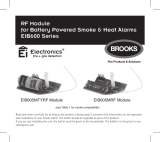 Brooks EIB605MRF Owner's manual
Brooks EIB605MRF Owner's manual
-
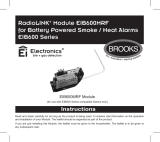 Brooks EIB600MRF Owner's manual
Brooks EIB600MRF Owner's manual
-
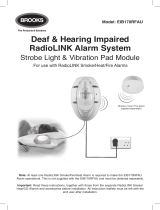 Brooks EIB170RFAU User manual
Brooks EIB170RFAU User manual
-
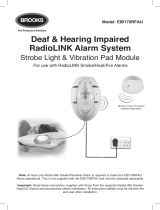 Brooks EIB170RFAUWEB Owner's manual
Brooks EIB170RFAUWEB Owner's manual
-
Aico 160 Series User manual
-
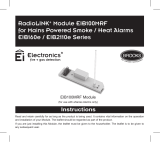 Brooks EIB100MRF Owner's manual
Brooks EIB100MRF Owner's manual
-
Aico Ei169RF User manual
-
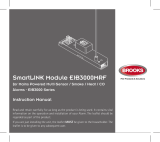 Brooks EIB3000MRF Owner's manual
Brooks EIB3000MRF Owner's manual








